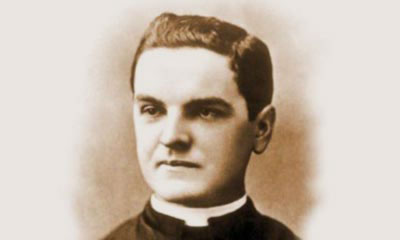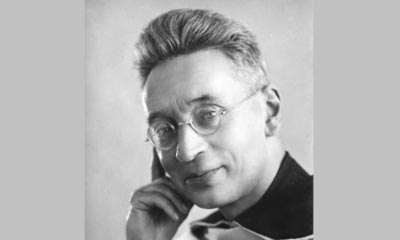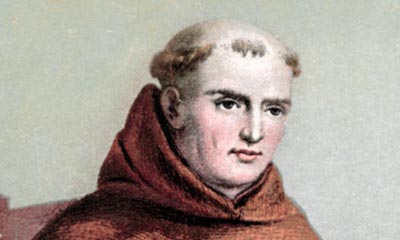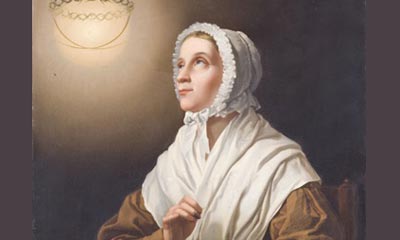April 26, 2023
Saint Dulce of the Poor
Dear Friends,
Shortly after the birth of her second child, Gabriel, on January 11, 2001, Claudia Cristina dos Santos suffered severe hemorrhage at the São José maternity hospital in Sergipe (Brazil). A prayer chain was organized to ask for the intercession of Blessed Sister Dulce, and a little relic of the nun was presented to the patient. Suddenly, the bleeding stopped. Dr. Sandro Barral, a member of the scientific committee that investigated the case, stated: “No one could possibly explain why the patient improved so fast under such unfavorable circumstances.”
 Mauricio, 22, from São Salvador da Bahia, Brazil, became totally blind as a result of glaucoma. Fourteen years later, in 2014, he developed conjunctivitis. Seizing an image of Sister Dulce, he held it to his eyes, full of faith, to relieve the pain. “When I woke up,” he later explained, “I started to see my hand. I realized that Sister Dulce had performed a miracle. She gave me so much more than I had asked for: I could see again!”
Mauricio, 22, from São Salvador da Bahia, Brazil, became totally blind as a result of glaucoma. Fourteen years later, in 2014, he developed conjunctivitis. Seizing an image of Sister Dulce, he held it to his eyes, full of faith, to relieve the pain. “When I woke up,” he later explained, “I started to see my hand. I realized that Sister Dulce had performed a miracle. She gave me so much more than I had asked for: I could see again!”
These two miracles were confirmed by the Church, and served for the beatification and canonization of Sister Dulce.
Maria Rita de Sousa Brito Lopes Pontes was born on May 26, 1914, in São Salvador da Bahia. At the beginning of the 20th century, industry and commerce were flourishing in the city, yet many of its inhabitants lived in poverty. Maria Rita was the daughter of Augusto Lopes Pontes and Dulce Maria de Souza. Her father was a dentist and a university professor. Her mother was a devout Catholic, and the atmosphere of their home was one of great faith. Fun-loving Maria Rita enjoyed playing with her dolls and flying kites. She was only seven years old when her mother died after having given birth for the sixth time; a few days later, the baby also died. The two eldest sisters, who were not married, came home to look after the three younger ones. The following year, Maria Rita received Holy Communion for the first time.
The gatehouse of Saint Francis
In 1924, Augusto Lopes remarried. His new wife proved very affectionate towards her husband’s children; two more would be born from the marriage. At thirteen, Maria Rita developed a passion for soccer. Her most dreaded punishment was to be deprived of the Sunday game. At the same time, Maria Rita grew particularly attached to her aunt Madalena, who was a member of a lay confraternity dedicated to the Sacred Heart, and who devoted herself to social work. The young girl accompanied her to the poor districts of the city, where religious ignorance was rife, and faith tainted with paganism. Maria Rita became involved with these poor people, bringing them food and clothing, and sometimes even gave them care. She soon expressed her desire to become a nun and began attending Mass every day. Her father jokingly said to her, “My daughter is already almost a Franciscan!” He was himself a benefactor, collaborator and member of the board of directors of a charity for workers in one of the poorest neighborhoods. With the consent of her family and the support of her sister, Dona Dulcinha, Maria Rita turned the family home into a care center for the needy that would soon be known as the “gatehouse of Saint Francis.”
One day Maria Rita went to a community of nuns in the hope of being admitted to their convent, but they objected that she was too young. Her father, who wanted her to marry, was not alarmed: he viewed the whole thing as a teenager’s passing fancy. Aged fifteen, at the end of her first year of training to become a teacher, the young girl wrote once more to the superior of the convent, again without success. By now her father had taken her request in earnest, but declared that he would not allow her to enter a convent before she had completed her education as a teacher, which would take three more years. When she finished her studies, Maria Rita met a Franciscan priest, Father Hildebrand Kruthaup (1902-1986), the first of a long line of priests who would be her guides. This German-born religious had been sent to Brazil in 1924 with a number of confreres in order to restore the Order of Saint Francis. It was under his guidance and thanks to his commendation that Maria Rita joined the congregation of the “Missionary Sisters of the Immaculate Conception of the Mother of God,” a branch of the Franciscan Order, in São Cristóvão in the state of Sergipe, 250 miles (400 km) from Bahia, in 1933. Maria Rita had graduated as a teacher, and her father gave his consent.
After years of living in the commotion of São Salvador, Maria Rita truly immersed herself in silence, welcoming this new way of life in joy and faith, and behaving like a discreet young girl. However, she never managed to do the housework and laundry without dirtying her clothes, earning many a rebuke from the Mistress of novices. She was the only graduate among those aspiring to the religious life, yet she humbly attended classes like the rest. After her postulancy, she received the religious habit with the name of Sister Dulce, in memory of her mother. Her model was St. Theresa of Lisieux: like her, the young novice strove to perform every ordinary action with love. She took her first vows on August 15, 1934, aged twenty. But she missed being with the poor.
The good angel of Bahia
The newly professed Sister was sent as a teacher to a school of the congregation in São Salvador. Despite her efforts, she failed to capture the interest of her students, nor could she keep order: this was not her vocation. In September 1935, she came to work at the Spanish Hospital in São Salvador, along with two other Sisters. During the four months she spent there, she worked as an auxiliary nurse, at the reception desk and as the head of the X-ray department. She excelled at combining medical care with spiritual assistance for the sick and for their relatives. Later, in 1941, she would begin training as a pharmacist. Meanwhile, in 1935, she took it upon herself to serve the poverty-stricken community of Alagados, who lived in a group of houses built on stilts. She visited the workers, praying with them and offering food and medicine to their destitute families, and encouraging them to fulfill their religious obligations. She would soon be known as the “Good Angel of Bahia.” Her visits were reported to Archbishop Alvaro da Silva as improper because the men were dressed in short pants: Sister Dulce was summoned to the Archbishop’s palace. She justified herself with ease and also proved that she did not interfere with the men’s work: “I only visit the factories at lunchtime, because that is the only time when the management allows me to.”
Together with Father Hildebrand, in 1936, she founded the city’s first workers’ movement, the Workers’ Union of Saint Francis, in view of organizing social solidarity and uniting workers in the Christian faith. Its purpose was not social advocacy, but the improvement of living conditions in a tangible way. The Union’s funding was provided by the employers and the wealthy people of the city who also joined in its activities. In contrast with the class struggle instigated by the Marxists, the Union promoted cooperation between the various components of society. The movement soon incurred the wrath of the Communists, who rightly saw it as a force opposed to their own.
In his encyclical Rerum Novarum of May 15, 1891, Pope Leo XIII stated: “The great mistake … is to take up with the notion that class is naturally hostile to class, and that the wealthy and the working men are intended by nature to live in mutual conflict. So irrational and so false is this view that the direct contrary is the truth… There is no intermediary more powerful than religion (whereof the Church is the interpreter and guardian) in drawing the rich and the working class together, by reminding each of its duties to the other, and especially of the obligations of justice.” Later, St. John Paul II would add in the encyclical Centesimus annus of May 1, 1991: “What is condemned in class struggle is the idea that conflict is not restrained by ethical or juridical considerations, or by respect for the dignity of others (and consequently of oneself); a reasonable compromise is thus excluded, and what is pursued is not the general good of society, but a partisan interest which replaces the common good and sets out to destroy whatever stands in its way” (no. 14).
All obstacles can be overcome with love!
In 1938, the Union became the “Bahia Workers’ Circle” (COB). Most of its members were poor; many were illiterate. For a very modest monthly fee, the Center provided them with medical and dental care, as well as recreational opportunities. Soon, training courses and workshops were set up. The Center also provided financial assistance to families in need. The association was presided over by a layman; Father Hildebrand was its ecclesiastical assistant. Sister Dulce had no official function, but worked there intensively. She enlisted her own father, who offered free dental care, and acted as an intermediary with the civil and ecclesiastical authorities. Sister Dulce was convinced that with love, you can overcome all obstacles and accept all sacrifices. It is in this state of mind that she intensified her efforts to relieve all kinds of misery. The COB experienced tremendous growth: by 1950, it had 25,000 members, leading it to become a real force for social progress in the city.
Saint John Paul II would later stress that “prominent” among rights “is ‘the natural human right’ to form private associations.” He clarified: “This means above all the right to establish professional associations of employers and workers, or of workers alone. Here we find the reason for the Church’s defense and approval of the establishment of what are commonly called trade unions: certainly not because of ideological prejudices or in order to surrender to a class mentality, but because the right of association is a natural right of the human being” (ibid., no. 7). The right of association allows the individual citizen to defend his or her dignity as a person, particularly in the face of arbitrary actions of the State and of the power of money. Its suppression in France by the “Le Chapelier Law” in 1791 led to the appearance of the proletariat, creating a favorable environment for the emergence of class struggle and communism. As the Catechism of the Catholic Church reminds us, the good of the people is the main objective of all economic activity: “The development of economic activity and growth in production are meant to provide for the needs of human beings. Economic life is not meant solely to multiply goods produced and increase profit or power; it is ordered first of all to the service of persons, of the whole man, and of the entire human community” (CCC, no. 2426).
In a chicken coop
In 1939, Sister Dulce opened a school in a working-class neighborhood of São Salvador, Santo António College, to provide education for workers in the evenings and for their children in the mornings. One afternoon of that same year, while she was working at the Circle, a young boy of about fifteen years old came in, famished and shivering with fever. He had an ugly cough, and begged for help: “Sister, don’t let me die in the street!” Since she could not accommodate him anywhere else, Sister Dulce took him to an abandoned house in a poor neighborhood nicknamed “Rat Island,” made him comfortable and provided him with care and medicine. In the following days, she occupied other houses with patients rescued from the streets. She received help from members of high society. Later, complaints from the neighbors led to the eviction of her protégés; she was forced to move them into an abandoned fish market, or under the arches of a viaduct, but the municipality made it clear to her that she would not receive permission for this. Sister Dulce skillfully delayed the enforcement of eviction notices, even going so far as to confront the prefect. A decade later, in 1949, she obtained permission from her superior to use the convent’s chicken coop, which she transformed into a makeshift hospice for the seventy people under her care. It consisted of a few huts in which the convent kept hens. When the superior asked her what she had done with the chickens, Sister Dulce answered that they had been used to feed the poor inmates… The nearness of the convent allowed Sister Dulce to take better care of them, and the sick did not feel abandoned when she returned to the convent. This is how the Santo António Hospital came to be. When patients were on the verge of death, she took care to provide them with the opportunity to confess. It also happened that she would bury the bodies of people who had died in the street. In such cases, she enlisted the help of sisters from her convent, and sometimes that of young girls from the Santo António College.
At the age of thirty-five, Sister Dulce developed tuberculosis. Overwork and her failure to take proper care of herself made the disease even worse. She agreed to spend forty-five days in a convent that served as a sanatorium, but she would still go on to suffer from significant respiratory difficulties. However hard she worked, she remained very faithful to the Rosary, and rarely fell asleep before having finished praying the fifteen decades. Considering that God’s grace was more important than her own efforts, she applied herself to constant prayer. I am the vine, you are the branches, said Jesus: whoever remains in me and I in him will bear much fruit, because without me you can do nothing (John 15:5).
German submarines repeatedly caused casualties along the Brazilian coast during the Second World War. Pressed by the local population, Brazil declared war on Germany in 1942. The Archbishop was forced to dismiss all German priests working in the diocese. Father Hildebrand was obliged to leave the COB and was replaced by a Brazilian Franciscan. This resulted in more work for Sister Dulce, who was increasingly being called upon. Her superior, who was worried about her growing involvement in the administrative life of the COB, forbade her from taking part in it. But many people sought her out personally, and she must continue her charitable work. Her gift for establishing personal contacts had turned her into the main source of funds for the Center. She launched fully-fledged fundraisers and, in 1946, secured financial support from prominent personalities and large corporations. In 1941, Father Hildebrand had met a young engineer, Norbert Odebrecht, the son of a German emigrant building contractor. Norbert was to become a valuable assistant to Sister Dulce: among others, they built a new headquarters for the COB, with much larger sanitary areas and a school.
“My Boss is demanding!”
As the population of São Salvador grew, the first shanty towns, “favelas” in Portuguese, sprang up. Sister Dulce visited them, and sought to remedy their most pressing needs. In 1950, she started coming to the aid of the inmates of a prison by improving their sanitary conditions. From 1952 to 1956, Sister Dulce served as superior of her convent of Santo António. As of 1954, her respiratory problems compelled her to sleep in a sitting position, but she knew that the suffering she offered up would attract graces from God. When people pointed out to her that her periods of rest were short, she would reply: “My Boss is demanding!”
In 1959, various charitable works in São Salvador da Bahia born of Sister Dulce’s initiatives were united under the name “Charitable Works of Sister Dulce” (OSID), which was recognized as a humanitarian association by the Brazilian authorities. The central nucleus of this association was the Santo António Hospital, which had become a modern 150-bed facility. At that time, Sister Dulce received American government aid, as her work was seen to offer powerful leverage against communism. The needy continued to pour in: her work expanded and she was joined by many volunteers. In 1984, she founded the Institute of the Daughters of Mary, Servants of the Poor, to help her in her work.
At that time, various schools of thought were creating unrest in the Church in Brazil; among them was “Liberation Theology.” Several persons attempted to attract Sister Dulce to this ideology, but she always remained faithful to the teaching of the Church, which led her to suffer much contradiction. In 1964, Sister Dulce inaugurated the Santo António Educational Center (CESA), in Simões Filho, to take in children without families. The farm where the CESA was located was donated by the government… That same year, Sister Dulce’s main supporter, Cardinal Alvaro da Silva, retired; Don Eugene Sales was named administrator of the archdiocese. Some nuns feared that their Institute would go bankrupt because of Sister Dulce’s undertakings and believed that these were not in keeping with the charism of the Institute. Bishop Sales, who held Sister Dulce and her poor in high esteem, obtained from Rome an indult of exclaustration of her community, which he imposed on her. She could thus continue her works, for which her Institute was no longer responsible, while still keeping her religious habit. The other Sisters left Santo António and moved to another location, leaving Sister Dulce on her own. This situation made it possible for her to continue to care for the school, the hospital and “her” poor.
From then on, Santo António became an annex of the OSID. Despite this surprising situation, the local superior and Sister Dulce continued to maintain a courteous written correspondence. In 1969, after the death of Cardinal Alvaro da Silva, Archbishop Eugene Sales became Archbishop of São Salvador, and had Sister’s exclaustration extended. In 1970, a new building was opened, doubling the hospital’s capacity to 300 beds. But there was conflict at times between Sister Dulce and the doctors, as she wanted all applicants to be admitted; they, on the other hand, argued that beyond a certain number, the risk of contagion would be too great… A new wing of the hospital, exclusively dedicated to the disabled, was inaugurated in 1974.
Those whom nobody wants
In 1976, thanks to the new archbishop of São Salvador, Sister Dulce was at last fully reintegrated into her religious congregation and completely absolved of any accusation of disobedience. But her health was failing: not only was her respiratory capacity reduced to a third of the normal level, she also suffered from successive bouts of pneumonia. Her only concern, however, was to care for the poor, especially those whom nobody wanted. Sister Dulce and Mother Teresa of Calcutta met in 1979 in São Salvador; the following year, during his first apostolic trip to Brazil, Pope John Paul II visited Sister Dulce… Notwithstanding several heart attacks, she still carried on with her many activities. In 1990, she was hospitalized for 16 months. In 1991, she suffered seizures accompanied by constant fever. Between attacks, she could only express herself by signs and gestures. She was often in coma. In October 1991, she was visited again by St. John Paul II during his second apostolic trip to Brazil. In November, advanced osteoporosis resulted in a fracture of her thigh bone. She spent the last days of her life in coma. She died on March 13, 1992, aged 77, in the hospital section of her convent of Santo António. Her body was exhumed in 2008 and transferred to the Cathedral of São Salvador: it was found to be intact. Sister Dulce was canonized on October 13, 2019 by Pope Francis as Saint Dulce of the Poor. A network of hospitals and medical care centers of the highest reputation, reserved for the poorest of the poor, and several social assistance centers constitute her legacy. Nowadays, they serve some five million people each year.
“Whenever you can, speak about love and with love to someone. It will benefit the ears of the listener and the soul of the speaker,” said Saint Dulce of the Poor. May this advice become the rule in our dealings with each other!









